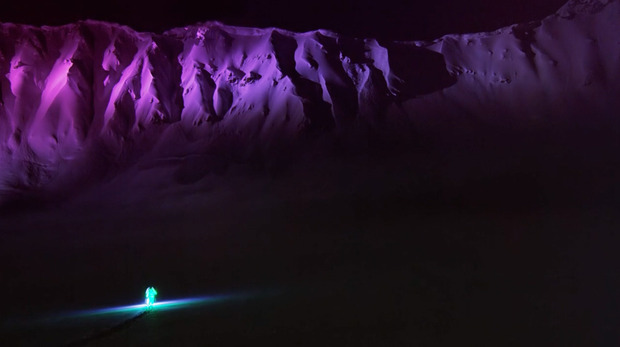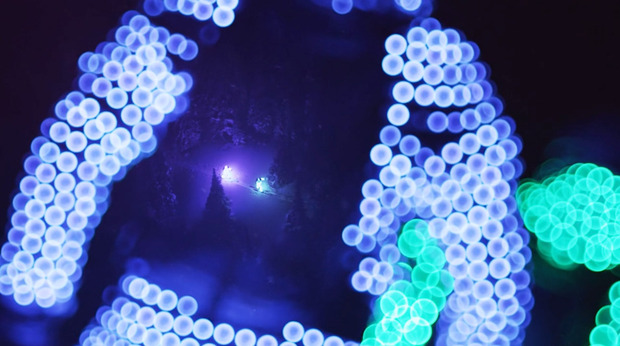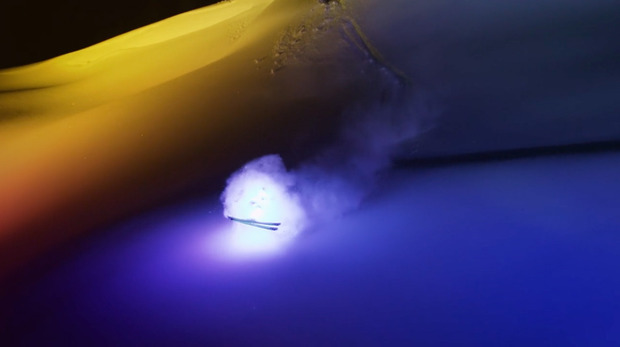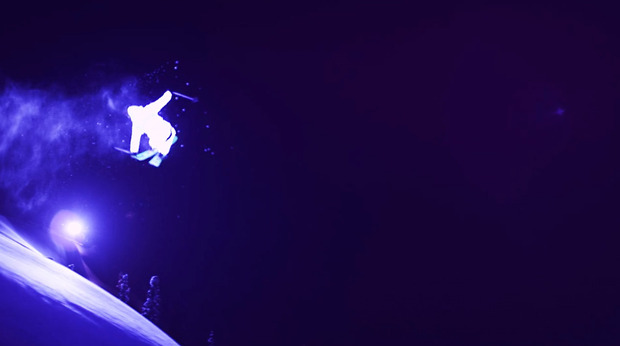Off Piste: Afterglow
Catching up with the creative minds at Sweetgrass Productions, who continue to push the limits of snow cinema with an inventive and illuminating new short film


Staying true to a clear creative vision while making films that capture the attention of an audience outside the snow sports world, the team at Sweetgrass Productions has garnered respect with viewers and industry professionals the world over. Helmed by NYC native Nick Waggoner, Sweetgrass explores the human instincts and emotional landscape that underpin the very motivation we all seek in adventures, challenges and overcoming obstacles. Their last feature, “Valhalla” (particularly the naked ski segment), captures the innocent joy of sliding down a snow-covered slope, while their upcoming short film “Afterglow” uses the pure power of high mountain night videography to tell a story of collaboration and perseverance. Their unique take on every creative project, along with dramatic, beautiful visuals and hard work from the athletes, results in films that are personal and niche, yet universal and commercially viable.
We caught up with Waggoner as he jetted off to Sweden to premier the film to discuss balancing interests on the shoot and lugging nearly five tons of gear around the wilds of Alaska.
Creatively, this is a departure from the bucolic, natural innocence of “Valhalla.” Can you tell me about the creative direction for “Afterglow”?
It’s definitely a creative departure. I really love how we get to wear such different hats with each new film. The mood and tone is so vastly different from each of our features to the next. They’re so immersive, that each film—for five months or two years—becomes our entire life. We lived “Valhalla,” and now we’re living “Afterglow,” and they’re vastly different. Valhalla was this organic, gritty soul and narrative, where this is a visual, clean and saturated, more modern and almost tech aesthetic. It almost screams for electronic music—a higher beat per minute.
Every film we’ve made always feels on the brink of complete failure, ultimately leaving us with morsels of wisdom about perseverance, determination and believing in our vision.
It’s not necessarily by design, but it’s important for us that we never make the same film twice, that we never settle into a rut of production that fails to challenge us or push our creativity. Every film we’ve made always feels on the brink of complete failure, ultimately leaving us with morsels of wisdom about perseverance, determination and believing in our vision—and that extends way beyond skiing or filmmaking.
The film has a branded aspect. How did you balance creativity with client satisfaction?
Through “Valhalla” we maintained 90% of creative control, if not more, on all of our productions. It’s definitely a learning experience to change that to closer to 50% or even 40%. It helps us to develop better communication, planning, scripting and collaboration, and I think that’s a big positive in the long run. Luckily the agency Ahlstrand & Wållgren were pretty hip to what’s hip and were incredibly cool to work with. Joakim Wallgren was our day-to-day contact there on all the creative elements and he, alongside Joakim Örnstig at Philips, were insanely supportive of our style and vision, and were also incredibly direct with what they did need and want to see in order to speak to their product, the Philips Ambilight TV.

Mike Brown, my co-director, did a pretty amazing job of working with them through the edit to make sure everyone was really proud to put their name on it. We’ll definitely find projects to keep the cowboy approach and full autonomy alive, but all said and done, this was a pretty radical opportunity to realize the dream of filming big mountain skiing at night.
Shooting in the mountains always carries hefty logistics, but all of the lighting equipment must have made this an unprecedented production.
The logistics around this film would require a volume of texts to detail, but suffice it to say, we had a team of four full-time producers, cranking from January to March, alongside two lighting professionals, researching lights and generators, charting distances on 3D topo maps and reading photometric charts to see what we could expect. The variables were endless. We were using these lights in environments they’d never been used. Could they withstand the cold down to nightly temperatures of -15º Fahrenheit? The near constant stream of blowing snow? How would the generators rated at sea level operate at 8,000 feet? What parts would break first? How many extension chords did we need? At what gauge?

Once we finally sorted out the kit—from advanced LED lights from AAdyntech that replaced 500 lb generators with 50 lb ones to our more traditional Arriflex Hollywood Cinema lights, we still had to deal with sourcing the equipment, getting it across an international border and then transporting it and a 14-person crew into the middle of nowhere. If you think you know what the middle of nowhere is, then imagine that this is two ranges beyond that, somewhere around where the flat world rolls over into monsters and fire-spitting dragons.
At one point in Alaska, we had to pull the plug on one location: moving 9000+ lbs of gear and 14 crew members, using five different types of aircraft—fixed wing and helicopter—70 miles from the nearest road, landing on remote, remote glaciers. We had two days to basically coordinate the work of a small military. Once the lights were lifted onto the glacier, a helicopter had to come in and pick up small packages of lights in nets on long cables and then deliver those nets to a person from our crew standing on a knife-edge ridge waiting to receive it and unclip the net. Absolute madness, but it’s definitely a point in production where you get this electrical feeling, this high, from the wildness of it all. It was weird, and completely wild and fresh. Some of it was well-planned, some of it was complete serendipity, and all of it was completely surreal.

After all that work, we almost got shut down that night when we went to film. As the darkness creeped in, our gaffer Mark Stuen came over the radio to say, “Not sure how to say this boys, but we’re missing a critical extension cord.” With the heli time, it ended up being a $3,000 cable.
What sort of design and technology went into the light suits?
Zac Ramras and Max Santeusanio, our two main producers, worked closely with a custom LED manufacturer to build the suits out. It involved getting the clothes direct from Patagonia and Arc’teryx, then sewing thousands of tiny LEDS into each article of Gore-Tex and wiring it with a battery the size of a candy bar. We really had no idea how they would resolve on camera until that first moment Pep Fujas dropped into a line and came over the first roll radiating blue. We all exploded over the radios, in complete awe, and made Pep wear the suit pretty much the rest of the trip. The environment tested them to the fullest, and Max and Zac were constantly running into the lodge to solder loose wires and fix broken elements of the suit at 4AM.

There’s a heap of shots in the light suit segment that are lit solely from the light suits themselves, and a handful of others where the scene is complimented by our big fixtures to create more dynamic color and depth. The athletes would be skiing entirely by the glow of the suit in some cases, seeing only 20-30 feet ahead at best.
Opting for a more analogue track for the light suit segment seems sort of counter intuitive with the high-tech vibe.
I’ll have to give credit to Mike Brown for finding the gem of “Silver Lining” by First Aid Kit. We’d been wrestling with the segment for a bit, feeling like a “Tron-like” track was what it needed. As we almost never use electronic tracks in our films, I think we were kind of excited to try something new. As soon as Mike showed us the First Aid Kit cut, the more folky, analog sound fit the visuals so much better and, again, gave them a depth and emotion that was really lacking from all the electronic tracks we had. Big high five to Mike for digging through the crates to come up with that one, as it really makes the segment.

It’s no wonder with all the high pressure logistics why you chose ski industry veterans. Can you tell me a bit about the athletes?
We were pretty selective with who we wanted to bring on, and I’m not sure we could assemble a harder working, humble and talented roster than Pep Fujas, Eric Hjorleifson, Chris Benchetler and Daron Rahlves. The amount of time, calories and patience those guys gave to the project goes deeper than anyone else ever would, and their work ethic found equal match in their cat-like moves on snow. I’m so impressed with what those guys were able to do in such dynamic and low visibility conditions. They were always the first to lift a generator or help make the production happen any way they could.
Check out the light suit segment now and stay tuned for future Sweetgrass Productions releases. “Afterglow” releases in its entirety 19 October 2014, with an online release and showings at festivals around the world in the coming months.
Images courtesy of Sweetgrass Productions
Off Piste encourages exploration. With each feature we’ll introduce the people, products and places that make life outside the city possible and life in the city more down to earth.












